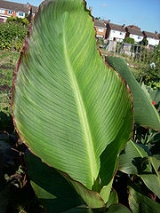
Canna discolor
Encyclopedia
Canna discolor also known as Achira in Colombia
is a species of the Canna
genus, belonging to the family Cannaceae, found naturally in the range from South Mexico to Colombia, widely introduced elsewhere. It is a perennial growing to 3m. It is hardy to zone 10 and is frost tender. In the north latitudes it is in flower from August to October, and the seeds ripen in October. The flowers are hermaphrodite
.
More than other Canna species, C. discolor is used extensively in agriculture
in Asia
. It grows high yields of very large rhizomes, sometimes the size of a man's arm, exceedingly rich in starch
.
from the Netherlands
and Nobuyuki Tanaka
from Japan. Inevitably, there are differences in their categorisations.
Maas considers Canna discolor to be a synonym of C. indica L., however, Tanaka's studies have revealed that C. indica can be clearly distinguished from other taxa, as a result he recognises several varieties:
Canna discolor var. discolor (Lindl.) Nb.Tanaka, 2001
A triploid, sterile both ways.
Canna discolor var. rubripunctata Nb.Tanaka, 2001
Green leaves with yellow flowers and many red spots. Seed parent sterile.
Canna discolor var. viridifolia Nb.Tanaka, 2001
No details available.
Colombia
Colombia, officially the Republic of Colombia , is a unitary constitutional republic comprising thirty-two departments. The country is located in northwestern South America, bordered to the east by Venezuela and Brazil; to the south by Ecuador and Peru; to the north by the Caribbean Sea; to the...
is a species of the Canna
Canna (plant)
Canna is a genus of nineteen species of flowering plants. The closest living relations to cannas are the other plant families of the order Zingiberales, that is the gingers, bananas, marantas, heliconias, strelitzias, etc.Canna is the only genus in the family Cannaceae...
genus, belonging to the family Cannaceae, found naturally in the range from South Mexico to Colombia, widely introduced elsewhere. It is a perennial growing to 3m. It is hardy to zone 10 and is frost tender. In the north latitudes it is in flower from August to October, and the seeds ripen in October. The flowers are hermaphrodite
Hermaphrodite
In biology, a hermaphrodite is an organism that has reproductive organs normally associated with both male and female sexes.Many taxonomic groups of animals do not have separate sexes. In these groups, hermaphroditism is a normal condition, enabling a form of sexual reproduction in which both...
.
More than other Canna species, C. discolor is used extensively in agriculture
Agriculture
Agriculture is the cultivation of animals, plants, fungi and other life forms for food, fiber, and other products used to sustain life. Agriculture was the key implement in the rise of sedentary human civilization, whereby farming of domesticated species created food surpluses that nurtured the...
in Asia
Asia
Asia is the world's largest and most populous continent, located primarily in the eastern and northern hemispheres. It covers 8.7% of the Earth's total surface area and with approximately 3.879 billion people, it hosts 60% of the world's current human population...
. It grows high yields of very large rhizomes, sometimes the size of a man's arm, exceedingly rich in starch
Starch
Starch or amylum is a carbohydrate consisting of a large number of glucose units joined together by glycosidic bonds. This polysaccharide is produced by all green plants as an energy store...
.
Taxonomy
In the last three decades of the 20th century, Canna species have been categorised by two different taxonomists, Paulus Johannes Maria MaasPaulus Johannes Maria Maas
Paulus Johannes Maria Maas is a botanist from the Netherlands and a specialist in the flora of the neotropics. Maas has identified and named about two hundred fifty plants from the Burmanniaceae, the Costus Family , the Gentian Family , the Bloodwort Family , the Banana Family , the Olacaceae, the...
from the Netherlands
Netherlands
The Netherlands is a constituent country of the Kingdom of the Netherlands, located mainly in North-West Europe and with several islands in the Caribbean. Mainland Netherlands borders the North Sea to the north and west, Belgium to the south, and Germany to the east, and shares maritime borders...
and Nobuyuki Tanaka
Nobuyuki Tanaka
Nobuyuki Tanaka is an economic botanist at the Tokyo Metropolitan University, the Makino Botanical Garden in Kōchi prefecture, Japan and the Forestry and Forest Products Research Institute , Japan....
from Japan. Inevitably, there are differences in their categorisations.
Maas considers Canna discolor to be a synonym of C. indica L., however, Tanaka's studies have revealed that C. indica can be clearly distinguished from other taxa, as a result he recognises several varieties:
Canna discolor var. discolor (Lindl.) Nb.Tanaka, 2001
A triploid, sterile both ways.
Canna discolor var. rubripunctata Nb.Tanaka, 2001
Green leaves with yellow flowers and many red spots. Seed parent sterile.
Canna discolor var. viridifolia Nb.Tanaka, 2001
No details available.
External references
- Kew Gardens, Checklist of plant families
- TAXONOMIC STUDIES ON SOME EASTERN AND SOUTHEASTERN ASIATIC TAXA OF CANNA (CANNACEAE) Nobuyuki Tanaka, Hiroshi Uchiyama, Tetsuo Koyama and Jin Murata;
See also
- CannaCanna (plant)Canna is a genus of nineteen species of flowering plants. The closest living relations to cannas are the other plant families of the order Zingiberales, that is the gingers, bananas, marantas, heliconias, strelitzias, etc.Canna is the only genus in the family Cannaceae...
- List of Canna species
- List of Canna cultivarsCanna (Plant) GalleryThis is a gallery of named canna cultivars, representative of the various Canna cultivar groups. Names of cultivars are regulated by the International Code of Nomenclature for Cultivated Plants, are registered with an International Cultivar Registration Authority and conform to the rules of the...

